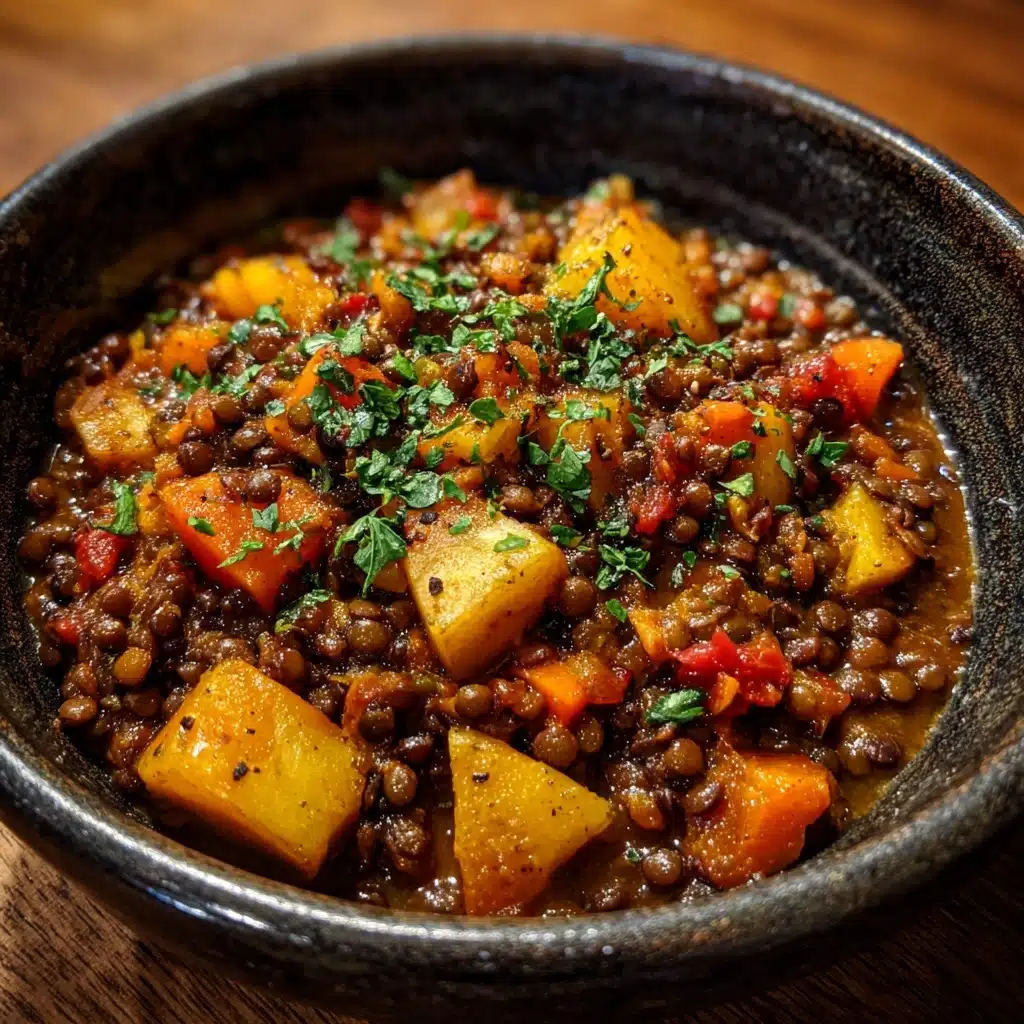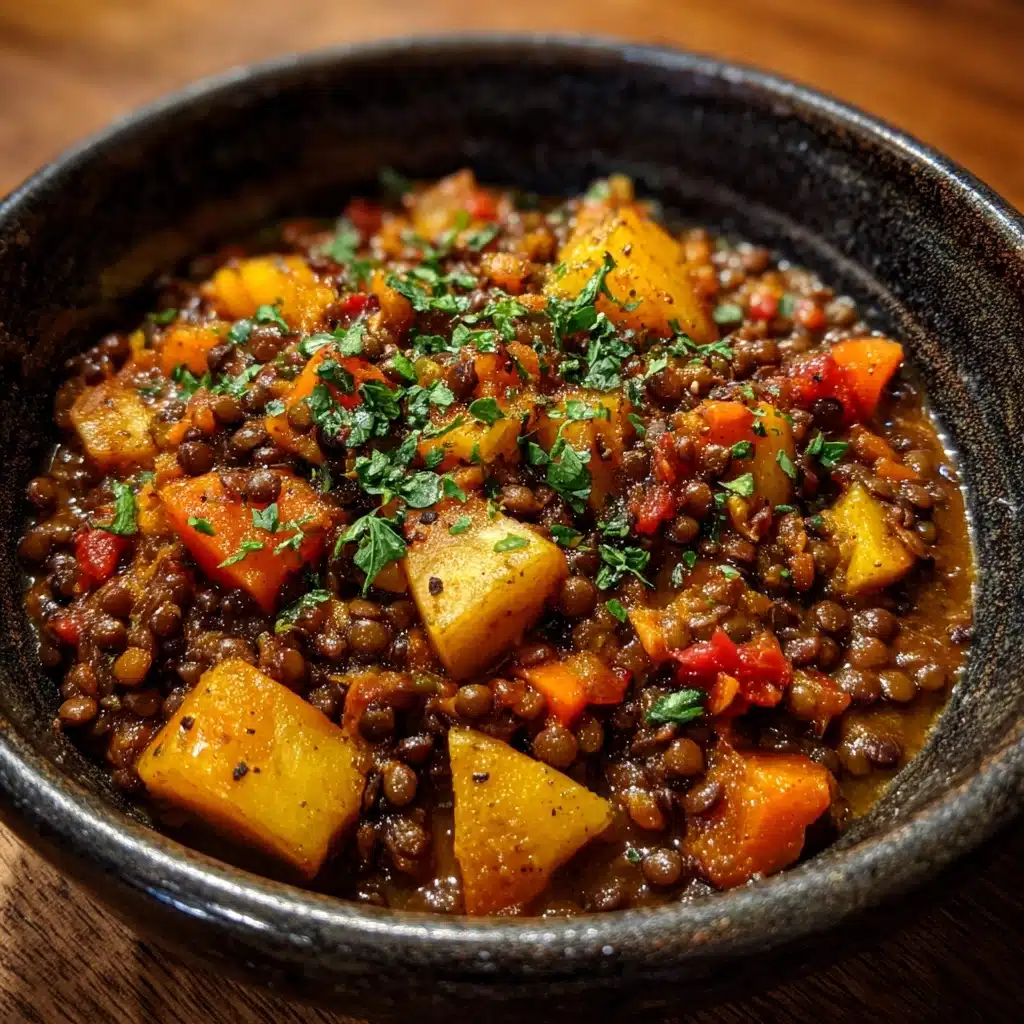If you’re searching for a soul-soothing meal that’s vibrant, hearty, and just happens to be packed with nourishing flavors, look no further than Ethiopian Lentil Stew (Misir Wat). This luscious stew brings together warming berbere spices, creamy red lentils, and the deeply aromatic niter kibbeh to create a dish that’s both comforting and boldly spiced. Whether you’re a longtime lover of Ethiopian cuisine Main Course.
Ingredients You’ll Need
It’s genuinely amazing how a handful of humble ingredients can produce a stew as complex and satisfying as Ethiopian Lentil Stew (Misir Wat). Every single component here pulls its weight, delivering color, texture, and authentic taste for a crowd-pleasing main dish you’ll want to make again and again.
- Niter kibbeh (spiced Ethiopian clarified butter) or unsalted butter: This is the aromatic backbone of the dish, infusing the stew with rich, savory depth from the very first step. For a vegan option, swap in plant-based butter or oil.
- Onion: Don’t skimp on the onion—it cooks down into sweet, golden softness and is essential for building flavor.
- Garlic: A few fresh cloves add a layer of gentle pungency and irresistible aroma.
- Fresh ginger: Grated or finely minced, this gives the dish a subtle, lively warmth you’ll love.
- Berbere spice blend: The iconic, fiery-red mix that brings heat, fragrance, and a gorgeous color—it’s what makes Ethiopian Lentil Stew (Misir Wat) unmistakably special.
- Red lentils: The hero protein; they cook quickly and break down to create a creamy, thick texture, plus they soak up all that spice.
- Vegetable broth or water: Broth adds extra savoriness, but water lets the spices shine; you can use whichever you prefer.
- Salt: Balances and heightens all the flavors, so taste as you go!
- Black pepper: Just a hint sharpens the finish and rounds out the savoriness.
How to Make Ethiopian Lentil Stew (Misir Wat)
Step 1: Sauté the Aromatics
Start by melting the niter kibbeh (or unsalted butter) in a large saucepan over medium heat. Once it’s beautifully fragrant and shimmering, add your chopped onion. Let it cook—slowly—until wonderfully soft and lightly golden, about 8 to 10 minutes. This patience pays off, laying the flavorful foundation that makes Ethiopian Lentil Stew (Misir Wat) unforgettable. Then stir in the garlic and ginger, and keep things moving for just a minute so their aromas bloom but don’t burn.
Step 2: Bloom the Berbere Spices
Sprinkle in the berbere spice blend next, stirring constantly as it mixes with the onion, garlic, and ginger. This short 1 to 2 minute sizzle draws out the oils in the spices and intensifies their flavor, tinting everything that signature deep brick-red color. This step gives Ethiopian Lentil Stew (Misir Wat) its distinctive, mouthwatering aroma!
Step 3: Simmer the Lentils
Now, add the rinsed red lentils and pour in your broth or water. Stir it all together, bring it to a gentle boil, then reduce the heat to low. Simmer uncovered for 20 to 25 minutes, stirring occasionally, until the lentils are meltingly tender and the stew thickens into a rich, spoonable consistency. It’s the kind of comforting texture that makes every bite feel like a hug.
Step 4: Season and Finish
Once your lentils are perfect, season the stew with salt and black pepper to taste. Taste as you go—the flavors should be bold yet well balanced. Stir everything one last time, then get ready to enjoy Ethiopian Lentil Stew (Misir Wat) at its finest: piping hot and deeply satisfying.
How to Serve Ethiopian Lentil Stew (Misir Wat)

Garnishes
Sprinkle freshly chopped cilantro, flat-leaf parsley, or a few rings of thinly sliced green onion over each bowl. Not only do these bring a pop of color, but their freshness brightens the stew’s spicy depth. If you love a little zing, a wedge of lemon on the side is a simple but tasty addition.
Side Dishes
Traditionally, Ethiopian Lentil Stew (Misir Wat) is served with injera, the wonderfully tangy and spongy Ethiopian flatbread that soaks up the stew’s flavors. If you don’t have injera, scoop it up with warm rice, soft pita, or even naan. A crisp green salad or some quick-pickled veggies add brightness on the side.
Creative Ways to Present
For a show-stopping dinner, serve your Ethiopian Lentil Stew (Misir Wat) as part of a platter with other Ethiopian vegetable dishes—think collard greens (gomen) or spicy potatoes (atkilt wat)—and let everyone scoop and share. Or, spoon it into small bowls for a cozy lunch, garnished with microgreens for an elegant touch.
Make Ahead and Storage
Storing Leftovers
Ethiopian Lentil Stew (Misir Wat) actually tastes even better the next day, so don’t hesitate to make extra! Once cooled, ladle leftovers into an airtight container and stash in the fridge. It will stay fresh for up to 4 days—perfect for make-ahead lunches or easy dinners all week long.
Freezing
This stew is a freezer superstar. Portion it into freezer-safe containers (leave a little room for expansion) and store for up to three months. Thaw overnight in the refrigerator or use your microwave’s defrost setting for a quick, wholesome meal whenever you need it.
Reheating
To reheat, pour the stew into a saucepan and warm gently over low heat. Give it a good stir and add a splash of water or broth if it’s become very thick—lentils continue to absorb liquid as they rest. Alternatively, microwave individual portions, stirring halfway through to ensure even heating.
FAQs
Can I use brown or green lentils instead of red?
While you can substitute other lentil varieties, keep in mind that brown and green lentils will take longer to cook and won’t break down as creamily as red lentils do. Ethiopian Lentil Stew (Misir Wat) is traditionally made with red lentils for that ultra-soft texture and bright color.
Is niter kibbeh necessary, or are there alternatives?
Niter kibbeh gives the most authentic flavor, but you can absolutely use unsalted butter, vegan butter, or a neutral oil instead. The stew will still be full of rich flavor, especially if you don’t skimp on the berbere and the aromatic base.
How spicy is berbere spice?
Berbere typically has a real kick, but the heat level depends on the brand or homemade recipe you use. If you’re spice-sensitive, start with a little less and add more to taste—Ethiopian Lentil Stew (Misir Wat) should be warming, but not overwhelming, unless that’s your vibe!
Can I make this stew oil-free or lower in fat?
You can reduce the amount of niter kibbeh or butter, or sauté the onions in a splash of broth instead. The stew will lose a bit of richness, but it’s still hearty and full of flavor, so feel free to make it match your dietary needs.
What’s the best way to source berbere if I can’t find it locally?
Check specialty food stores, well-stocked spice shops, or online retailers. Many major websites offer authentic Ethiopian berbere blends, and you can even try making your own if you love a kitchen adventure—it’s a fun way to make Ethiopian Lentil Stew (Misir Wat) extra special!
Final Thoughts
If you’re ready for a meal that’s both deeply comforting and a little bit adventurous, give Ethiopian Lentil Stew (Misir Wat) a try. It’s easy, wholesome, and sure to warm up your kitchen and your heart—one spoonful at a time. I hope this recipe brings a little taste of Ethiopia’s vibrant cuisine to your table soon!
PrintEthiopian Lentil Stew (Misir Wat) Recipe
A flavorful and aromatic Ethiopian Lentil Stew, known as Misir Wat, that combines red lentils with a rich blend of spices and aromatics. This hearty stew is perfect for a comforting and satisfying meal.
- Prep Time: 10 minutes
- Cook Time: 30 minutes
- Total Time: 40 minutes
- Yield: 4 servings 1x
- Category: Main Course
- Method: Stovetop
- Cuisine: Ethiopian
- Diet: Vegetarian
Ingredients
For the Stew:
- 2 tbsp niter kibbeh (Ethiopian spiced clarified butter) or unsalted butter
- 1 large onion, finely chopped
- 3 cloves garlic, minced
- 1 tbsp fresh ginger, minced
- 3 tbsp berbere spice blend
- 1 cup red lentils, rinsed
- 3 cups vegetable broth or water
- 1/2 tsp salt
- 1/4 tsp black pepper
Instructions
- Melt the Butter: In a large saucepan over medium heat, melt the niter kibbeh.
- Cook Aromatics: Add onion and cook until soft and golden. Stir in garlic and ginger.
- Add Spices: Stir in berbere spice blend and cook to bloom the spices.
- Cook Lentils: Add lentils and broth. Simmer until lentils are tender and stew thickens.
- Season and Serve: Season with salt and pepper. Serve warm with accompaniments.
Notes
- For a vegan version, use vegetable oil or plant-based butter instead of niter kibbeh.
- The stew will thicken as it cools, so add a splash of water or broth when reheating.
Nutrition
- Serving Size: 1 cup
- Calories: 230
- Sugar: 5 g
- Sodium: 400 mg
- Fat: 7 g
- Saturated Fat: 4 g
- Unsaturated Fat: 3 g
- Trans Fat: 0 g
- Carbohydrates: 32 g
- Fiber: 13 g
- Protein: 12 g
- Cholesterol: 15 mg




